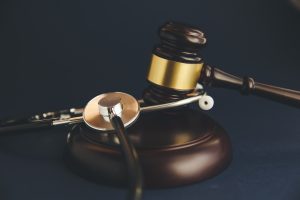[vc_row][vc_column][vc_column_text]When it comes to medicine, law, and the government, there are fewer circumstances that unite these three separate practices than with a pandemic. This year, the world experienced what would soon be a ‘household name,’ so to speak: the COVID-19 pandemic. Unlike previous pandemics and epidemics, COVID-19 allowed such an extensive spread to impact the global political, social, and economic arenas.
You might be surprised to learn that “coronavirus” is a noun, with coronaviruses being a large group of viruses that cause diseases in animals and humans. According to an article on the National Foundation for Infectious Diseases (NFID) website, coronaviruses “often circulate among camels, cats, and bats, and can sometimes evolve and infect people.”

Coronaviruses are named for the crown-like spikes on their surface (“corona” in Spanish translates to “crown” in English)
The 19 in COVID-19 distinguishes the year that this particular virus spread.
The first cases of human coronaviruses were identified in the mid-1960s and have since taken on a new notoriety level. In 2019, COVID-19 emerged in a seafood and poultry market in the Chinese city of Wuhan. The World Health Organization (WHO) characterized the outbreak as a pandemic on March 11, 2020, when cases were detected in most countries worldwide. With this pandemic, medicine, law, and government are being forced to collaborate (like a school project with ideal classmates), in an attempt to minimize the spread of the virus and keep people protected worldwide.
In a publication by William S. Hein & Co., Inc., we’re reminded that the year 2020 has “seen the COVID Pandemic cause postponement of [major events]” such as the summer Olympics and Expo 2020. Other large events were canceled, with COVID-19 changing the way we operate as a collective. People have become hyperaware of hygiene processes so that they can keep themselves clean, healthy, and safe. In addition to getting used to cleaner-than-usual hygiene habits, keeping a distance of 6-feet in high-traffic places, and learning how to communicate via technology instead of face-to-face have all been deemed as important by medical professionals, lawyers, and government officials alike.
For the Raynes Erickson team, talking about COVID-19 is no new business. In past articles, we discussed how the pandemic has affected the elderly in our blog titled, “What You Need to Know About Coronavirus and the Elderly.” We’ve also asked the question, “Is A Contributing Factor To Increased Fatal Car Accidents COVID-19?” in addition to addressing how the medical industry has changed since the pandemic in our blog, “Medical Malpractice and COVID-19.”
In all of these blogs, we discuss changes that have been implemented on a worldwide scale as a result of the COVID-19 pandemic. It’s evident that with the pandemic, everyone must be involved in order to make progress. And, quoting, that same William S. Hein & Co. publication from earlier, “There has emerged a new appreciation of frontline medical personnel and it is even possible that the heroes of the future will be physicians and scientists, […].” This is not to say that the latter is more superior than the former; medical professionals are frontline workers in the midst of a pandemic. By default, these professionals are risking their lives in order to care for those who need medical assistance.
With the rather subtle and expected-turned-gregarious arrival of the pandemic, there was a blurred line between medical malpractice and COVID. For example, we addressed some tricky scenarios that might be viewed as medical malpractice or professional neglect for elderly victims. What if a medical professional or elderly caregiver failed to wash their hands when dealing with elderly patients, or failed to frequently disinfect frequently-touched surfaces, including doorknobs, tables, rails, light switches, countertops, toilets, and the like? While these questions appear rhetorical in and of themselves, we understand how the pandemic created a blurred line between medicine and malpractice.
Interpersonal relationships may have either “strengthened or fractured” as a result of lockdowns and isolation
With job losses skyrocketing, reliance on Government support likewise increased. We remember the stimulus check that many people received in the summer; that’s when the government comes in. With the virus prompting many businesses to lay-off employees, the result is a decline in employment and, by extension, the economy. To better understand the relationship between government, medicine, and law, let’s take a look at Australia:
“By the end of February 2020, the Federal Government outlined some of its Pandemic responses, such as: canceling large gatherings; people working from home; and boosting the capabilities of hospitals (4). The message was that the State and Territory Governments were responsible for: public health responses; contact tracing; distribution of antiviral drugs; social distancing (including closing schools and work places [sic], quarantining people, canceling events and possibly shutting down public transport); implementing infection control guidelines; and protecting people in aged care facilities and institutions.”
 This reliance on government authorities to call the next shot also leaked into how medical professionals successfully carry out their duties. For example, it’s noted that a diagnosis usually requires the physical presence of the patient to make a clinical examination of that patient and/or to order special tests. Prescribing medicine, without having seen or examined the patient, would normally constitute negligence. However, in the context of COVID-19, the government had issued new healthcare guidelines about healthcare that permit telemedicine. One of the guidelines recommends healthcare providers to limit their consultations to urgent and necessary consultations. Non-urgent and non-necessary medical interventions must be postponed. Consultations remain possible via telemedicine.
This reliance on government authorities to call the next shot also leaked into how medical professionals successfully carry out their duties. For example, it’s noted that a diagnosis usually requires the physical presence of the patient to make a clinical examination of that patient and/or to order special tests. Prescribing medicine, without having seen or examined the patient, would normally constitute negligence. However, in the context of COVID-19, the government had issued new healthcare guidelines about healthcare that permit telemedicine. One of the guidelines recommends healthcare providers to limit their consultations to urgent and necessary consultations. Non-urgent and non-necessary medical interventions must be postponed. Consultations remain possible via telemedicine.
The direct impact of what’s occurring in the medical industry versus what the government is mandating both serve as a sort of cause and effect toward one another. Had the government not utilized its legal authority to minimize face-to-face contact, medical professionals would’ve been more susceptible to the virus; had medical professionals not been susceptible to the virus, government officials likely wouldn’t have found it necessary to implement virtual healthcare the way it did. Laws, which are dictated by the government, have a direct bearing on what the medical professionals are doing, and what the medical professionals are doing have a direct bearing on the kinds of laws the government will pass.
We can better prepare for the future if we understand the dos and don’ts of how we tried to manage the latest COVID-19 pandemic
Let’s not wait to inform appropriate authorities about an outbreak could have detrimental results; we should be proactive as opposed to reactive.
International and professional communities had begun to doubt the legitimacy of the WHO because it failed to emphasize the early signals of the virus from China, at the end of December 2019. As mentioned earlier, the WHO only announced a global pandemic on March 11th, 2020, after multiple countries had already implemented states of emergency. However, since the government, medical professionals, and those who study and practice law are all under obligation to care for patients (by extension: citizens and clients), these industries need each other in order to successfully perform their duties; if one is neglecting another, there could be dire consequences.
Some people believe that the main purpose of this crisis was to collapse the global economy, paralyze states through public panic, and influence target political processes. As interesting as this theory sounds, there might be some validity to it. States should have preventive measures and strategies to combat such theories, potentially becoming reality. As most did not, the majority of leaders were disoriented to guide the nations on the right path.
As such, 2020 has taught us that any pandemic automatically involves medical professionals because lives are at-risk; the government is then sought to make appropriate decisions to protect its citizens (such as instituting social distancing and mandating quarantining); if there is non-compliance with the newly established rules and regulations, legal experts can get involved to prepare legal documents and interpret laws, regulations, and rulings to support the decisions of the government.

Besides the negative factors brought on by COVID-19, some positive aspects have also been unveiled. There is a far greater appreciation of the need for better hygiene, protecting staff in shops and commercial premises, better cleanliness everywhere with ubiquitous hand-sanitizers and other attention to detail to sterilize public transport and public places. There is increased respect for the medical profession in society, attention to personal hygiene. There’s been a cessation of military conflicts in addition to environmental benefits and moral changes in terms of solidarity and equality. What else can we say?
As difficult as the pandemic has been for all of us, the old adage is true that every cloud has a silver lining. In our special feature on the pandemic titled, “How COVID-19 Is Forcing a Revolution in the Medical Industry: Making Virtual Healthcare the ‘New Norm’,” we open with, “The medical industry’s establishment of virtual healthcare is one example of how this pandemic is helping us develop as a society.” Of course, this advancement in how we practice medicine wouldn’t have been possible if it weren’t for the government institute laws to limit face-to-face communication. As such, we’re seeing more ways in which medicine, government, and law work harmoniously for the protection of the people.[/vc_column_text][/vc_column][/vc_row]
